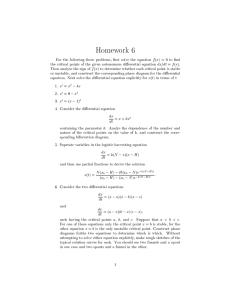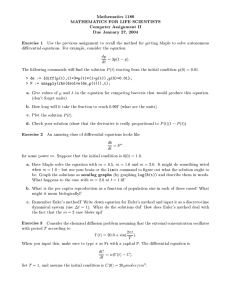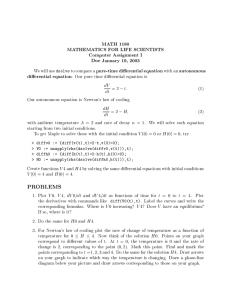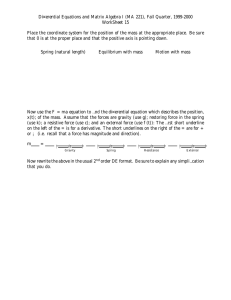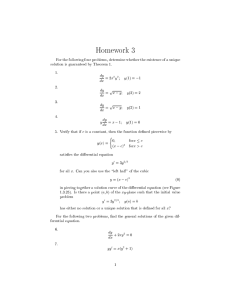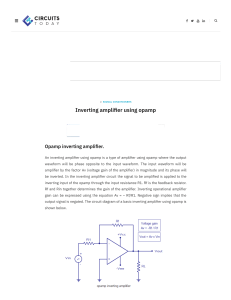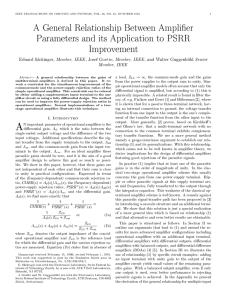Project 1
advertisement
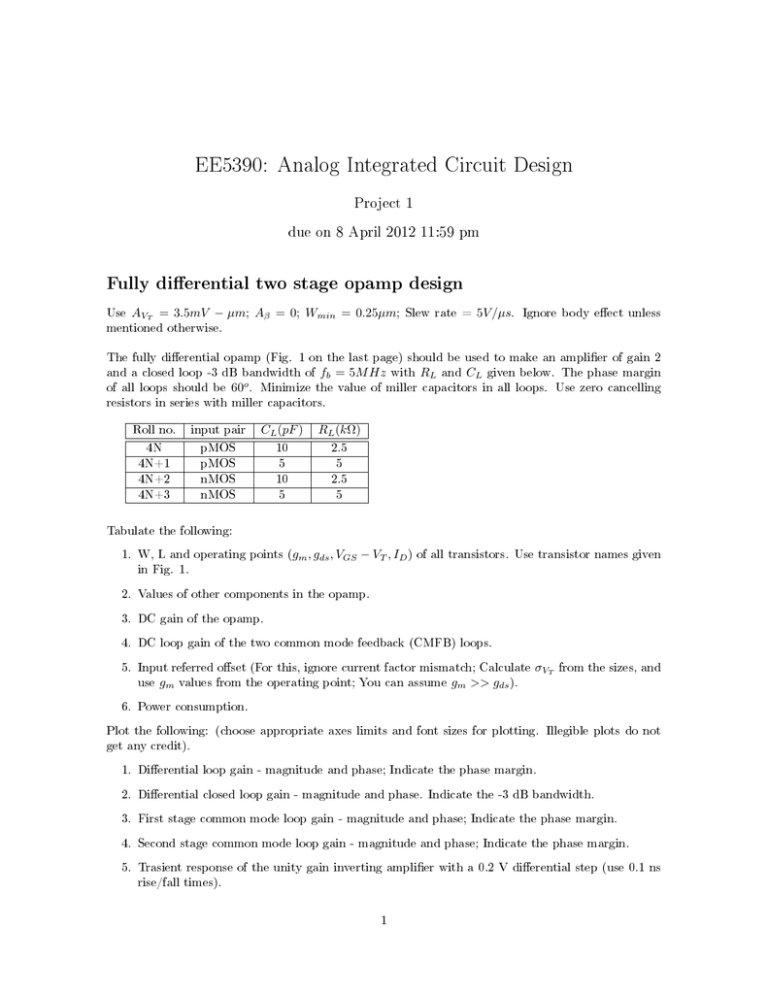
EE5390: Analog Integrated Circuit Design Project 1 due on 8 April 2012 11:59 pm Fully dierential two stage opamp design Use AVT = 3.5mV − µm; Aβ = 0; Wmin = 0.25µm; Slew rate = 5V /µs. Ignore body eect unless mentioned otherwise. The fully dierential opamp (Fig. 1 on the last page) should be used to make an amplier of gain 2 and a closed loop -3 dB bandwidth of fb = 5M Hz with RL and CL given below. The phase margin of all loops should be 60o . Minimize the value of miller capacitors in all loops. Use zero cancelling resistors in series with miller capacitors. Roll no. 4N 4N+1 4N+2 4N+3 input pair pMOS pMOS nMOS nMOS CL (pF ) RL (kΩ) 10 5 10 5 2.5 5 2.5 5 Tabulate the following: 1. W, L and operating points (gm , gds , VGS − VT , ID ) of all transistors. Use transistor names given in Fig. 1. 2. Values of other components in the opamp. 3. DC gain of the opamp. 4. DC loop gain of the two common mode feedback (CMFB) loops. 5. Input referred oset (For this, ignore current factor mismatch; Calculate σVT from the sizes, and use gm values from the operating point; You can assume gm >> gds ). 6. Power consumption. Plot the following: (choose appropriate axes limits and font sizes for plotting. Illegible plots do not get any credit). 1. Dierential loop gain - magnitude and phase; Indicate the phase margin. 2. Dierential closed loop gain - magnitude and phase. Indicate the -3 dB bandwidth. 3. First stage common mode loop gain - magnitude and phase; Indicate the phase margin. 4. Second stage common mode loop gain - magnitude and phase; Indicate the phase margin. 5. Trasient response of the unity gain inverting amplier with a 0.2 V dierential step (use 0.1 ns rise/fall times). 1 6. Trasient response of the unity gain inverting amplier with a 0.1 V common mode step (use 0.1 ns rise/fall times). 7. Slew Rate should be simulated and plotted for both positive and negative steps. Input for the closed-loop amplier should be stepped from a) 0 to VDD and b) VDD to 0. 8. Input referred noise spectral density - identify 1/f noise corner. Show relative contributions from dierent devices at 10 MHz. Do not use ideal current sources in the tail. You can use one ideal reference current source of 1/10th the tail current of the input dierential pair for bias generation. Design the bias generator block that generates bias currents and voltages required in the opamp. Try to determine as many parameters as possible from the specications and choose sensible starting points for the others. You can assume a gate over drive of 200 mV in your initial calculations. Make sure to use replicas correctly (i.e., same transistor length) wherever applicable. vop vop1 vom1 + + 100 KΩ C2 100 KΩ C2 + cmfb1 Vcmref1 - Vdd/2 cmfb2 - vom cmfb1 Vdd Vdd M5 vom1 Ccm1 M2 cmfb1 vop1 vim C vop Vdd Mc20 Mc14 M6 vop1 Ccm1 M1 vip C Mc13 M4 M3 vom1 Mc11b Mc12 Mc11a Vcmref1 Mc22 Mc21 vom cmfb2 Ccm2 Ccm2 M0 I0 Mc10 M7 Vcmref2 Mc23 Mc24 M8 cmfb2 (a) (b) (c) 20 KΩ CL Vdd/2 +vi/2 10 KΩ I0/10 RL − RL Vdd/2 -vi/2 10 KΩ + Vdd − Vdd/2 + CL 20 KΩ (d) (e) Figure 1: (a) Fully dierential two stage opamp (Zero cancelling resistors not shown), (b) First stage common mode feedback, (b) Second stage common mode feedback, (d) Closed loop amplier, (e) External connections to the opamp. With a pMOS input pair, all transistors will be of the opposite polarity. 2
